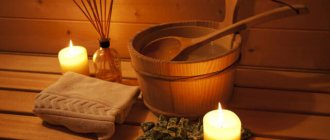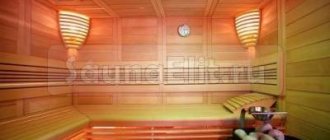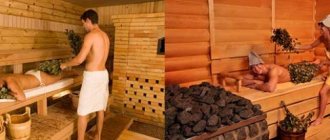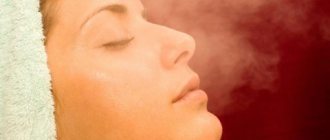Currently there is a real “sauna boom”. The number of SPA hotels for every taste and budget is growing, separate bath complexes are opening, and bathhouses are springing up like mushrooms on the sites of country houses. The bathhouse has turned not only into an opportunity to carry out hygienic procedures, but also into something special - into a colorful room where you can enjoy incomparable sensations, into a meeting place for friends and celebrations, into an opportunity to relax and quickly restore strength, while receiving an additional surge of strength and energy. Today you can choose not only a Russian bath, but also a Finnish sauna, Turkish hammam, Roman bath, Japanese furo, salt and infrared baths.
This variety allows you to choose an option in each specific case based on your state of health and aesthetic preferences.
What is the difference between a Russian bath and a sauna?
A sauna with dry air in a steam room is used for medicinal purposes, while a Russian steam bath is used for hygienic and preventive purposes.
A steam bath, unlike a dry-air sauna, puts more stress on the cardiovascular, respiratory and nervous systems of the body. Therapeutic effects of bath procedures:
| Peculiarities | Russian bath | Finnish sauna |
| Options | t 40–80 ºC, relative humidity 60–70% | t 105–110 ºC, relative humidity 5–10% |
| Therapeutic effects | Vasodilator, diaphoretic, secretory | Vasodilator, diaphoretic, lymphatic drainage, thermoadaptive, anti-inflammatory |
- The physiotherapeutic effect of a Finnish bath consists of dry sweating with physical and mental relaxation and alternating extreme heating of the body with subsequent cooling.
- In a Russian steam bath with moist air, sweating occurs less than in a dry Finnish one.
The bathhouse is useful only if you strictly adhere to the rules for visiting the steam room:
- Before entering the sauna, take a shower and wipe yourself dry. Sick people stay in the steam room for no more than 3–5 minutes, healthy people – 7–10. Then the body is cooled - doused with cold water, bathed in a pool or washed with cold water on the limbs. The cold procedure takes no more than 3–10 minutes. A cooled body needs to rest for 15–20 minutes. The set of procedures is performed 2–3 times.
- Before visiting the wet steam room, warm up under a warm shower for 2–3 minutes. The head is protected from overheating with a towel turban or a hat with a brim. The first time they enter the steam room for 5–6 minutes, they do not use a broom. When entering again, they steam with a broom. People enter the steam room 2–3 times, with rest breaks of 15–20 minutes. The total duration of stay in a wet steam room for healthy people is up to 30 minutes, for patients – 10–15 minutes.
You can't take a steam bath
On a full and empty stomach. You need to eat an hour or an hour after the bath.
While intoxicated. High temperatures cause intoxication faster, and alcohol impairs coordination, which can lead to injuries and burns.
Do not try to stay in it for more than the time that your body can tolerate.
Do not stand under ice water after a steam room. For an unprepared person, a sudden change in temperature can result in sudden cardiac arrest.
In between visits to the steam room you need to drink, preferably herbal tea. This compensates for fluid loss.
For what diseases is a bath useful for men and women?
Under the influence of heat and steam, the body is cleansed - along with sweat, urea is released, which is useful for gout on the legs, lactic acid, salts and harmful products of metabolic processes, heavy metals that are contained in the body.
Staying in a bathhouse for 15–30 minutes leads to an increase in the number of red blood cells by 10–12%, which carry oxygen from the lungs to the body tissues. The hemoglobin content increases.
Breathing increases significantly - the force of inhalation and exhalation, as well as the vital capacity of the lungs (VC) increases. Body temperature rises to a maximum of 39.4°. Steaming with a broom promotes a strong outflow of blood from internal organs to the periphery. Metabolism improves.
The benefit of a bath for the prevention and treatment of diseases of the respiratory system lies in the effect of hot steam on the thermoreceptors of the skin and mucous membranes of the respiratory system. In patients with chronic bronchitis, bronchial patency improves.
Indications for treatment with bath procedures in a dry air sauna:
- tendency to colds;
- chronic nonspecific diseases of the respiratory system;
- peripheral circulatory disorders;
- hypotension;
- arterial hypertension in the initial stage;
- chronic disorders of the digestive system;
- obesity;
- chronic skin diseases;
- chronic disorders of the musculoskeletal system;
- chronic inflammatory diseases of the genitourinary system in remission.
For human health, a steam bath is useful for the following diseases:
- chronic bronchitis in remission;
- infectious-allergic form of bronchial asthma with rare attacks;
- chronic pneumonia in remission;
- radiculitis of the lumbosacral region;
- inflammatory diseases of the joints;
- dyskinesia of the gallbladder and bile ducts;
- neuroses;
- arterial hypertension in the initial phase;
- dermatological diseases - eczema, urticaria, atopic dermatitis, furunculosis, and psoriasis.
Under the influence of hot steam, blood vessels dilate, improving blood supply to internal and external organs - skin, muscles and joints.
Metabolic processes are activated, which leads to increased oxygen consumption and increased release of carbon dioxide.
Contraindications
Well, are you ready to run and get healthier? Stop! Do not hurry. In order for the steam room to wrap you in a shawl woven from threads of health and beauty, you need to familiarize yourself with the contraindications, otherwise you can harm the body. Thus, visiting the bathhouse is strictly prohibited if a person has:
- cancer;
- AIDS;
- tuberculosis;
- anemia;
- endocarditis;
- myocarditis;
- peritonitis;
- tachycardia;
- hypertension;
- epilepsy;
- hepatitis;
- predisposition to bleeding;
- acute ENT diseases;
- brain injury;
- inflammatory processes of the skin of the body;
- exacerbation of chronic diseases;
- elevated body temperature.
In general, before going to the sauna you need to visit a doctor to avoid irreversible consequences.
The best sauna for peeling and massage
Due to the low temperature and 100% humidity, a Turkish bath or hammam is suitable for a cosmetic massage.
In a Turkish bath, heated floors, benches and tables for lying on are heated either by water heating through pipes or by warm air through cavities inside. The final temperature is formed by forcing saturated steam through holes in the walls.
In a bath with such high humidity, steam condenses on the skin, forming a protective film. Sweating does not start until the body warms up and the vapors stop condensing. This allows you to stay in the steam room much longer, and the slow warming of the body is ideal for a massage procedure. The hammam, thanks to its gentle microclimate, is good for allergy sufferers and those with sensitive skin.
The soft steam of a Turkish bath opens pores, helping to remove toxins from skin cells and improve its condition. The steam of a Turkish bath saturates dry skin with water molecules and softens it, and removes excess sebum from oily skin, making it healthier.
A visit to the hammam involves certain cosmetic procedures. After heating and steaming the skin, a massage is performed - soft soapy and/or hard, performed with special woolen mittens. This massage increases blood flow, normalizes lymph circulation, restores flexibility to joints and makes the skin soft and velvety, like after peeling. After the massage, it is recommended to do wraps - honey, chocolate and others. Finally, the body is doused with cold water.
A Turkish bath perfectly relaxes, treats insomnia and improves your mood. It is not for nothing that in its homeland the hammam is a long-lasting ritual of beauty and relaxation.
The kidneys and liver “rest” in the sauna and bathhouse
Increased sweating reduces the load on the kidneys, and they are on a “short-term vacation.” Urine production decreases within the first minutes and remains reduced for several hours after leaving the sauna. However, in case of urolithiasis and severe kidney diseases, it is better not to take risks with a steam room.
Liver
The sauna relieves not only the kidneys, but also the liver. Heat improves the secretion of bile, and the gallbladder is freed from stagnant bile. “Relationships” in the intestines are normalized, due to increased lymph flow, the intestines are freed from toxins. The influence of high temperature also has a beneficial effect on the intestinal flora, preventing the development of dysbiosis.
But in case of severe inflammation of the liver, cirrhosis, exhaustion, or exacerbation of peptic ulcer disease, the bath is contraindicated.
Physiological changes in the body under the influence of high temperatures
Mechanisms of thermoregulation
Visiting baths and saunas with extreme temperatures for humans (from 40 to 100 °C and above) has not only a tonic, but also a stressor effect. Under such conditions, the body receives much more thermal energy than it is able to remove using the thermoregulation mechanism. In this case, two stages are possible:
1) Adaptations (positive effect): skin blood flow and lymph microcirculation are significantly increased, peripheral vessels dilate, sweat is intensely released.
2) Disadaptation (negative impact): regulatory mechanisms stop working, the balance of electrolytes and homeostasis (constancy of the internal environment) are disrupted, the sweat glands malfunction, and the person overheats.
The art of a proper bath procedure is to take advantage of the positive effects within the framework of adaptation and prevent the body from overheating, when acute conditions and complications of chronic diseases are possible.
9 hormones that control the functioning of the body in the bath and sauna
When visiting a bathhouse or sauna, a person exposes himself to thermal baths and water procedures, such as dousing with ice water, cold showers, and immersion in a pool. As a result, short-term hormonal surges occur that control metabolism and affect well-being. Let's consider the most active biological regulators and their action:
1) Beta-endorphin - an increase in concentration by 2-10 times - creates a feeling of euphoria and well-being, relieves pain and depression, and inhibits intestinal motility.
2) Aldosterone - an increase in concentration by 3-6 times - retains water and chlorides, enhances the reabsorption (reabsorption) of sodium.
3) Renin - an increase in concentration by 1.5-2 times - increases blood pressure.
4) Norepinephrine - an increase in concentration by 2-4 times - increases peripheral vascular resistance, increases coronary blood flow and blood pressure.
5) Somatropin (growth hormone) - increase in concentration by 2-5 times - stimulates the breakdown of fats, activates protein synthesis, reduces blood glucose levels.
6) Adrenaline (epinephrine) - when immersed in cold water, the concentration increases 2-3 times - causes constriction of blood vessels in the skin, abdominal cavity and mucous membranes, leads to increased heart rate, increases tissue metabolism, and increases blood pressure.
adrenalin
7) Prolactin - an increase in concentration by 2-10 times - has an immunostimulating effect, reduces sexual excitability and pain sensitivity.
 Angiotensin II - an increase in concentration by 3 times - narrows veins and arteries (pressure increases), causes a feeling of thirst, helps the production of norepinephrine and the loss of potassium.
Angiotensin II - an increase in concentration by 3 times - narrows veins and arteries (pressure increases), causes a feeling of thirst, helps the production of norepinephrine and the loss of potassium.
9) Vasopressin - increase in concentration by 1.5-2 times - retains water, dilutes the plasma by reducing sodium content.
There are also hormones whose levels remain unchanged (testosterone, insulin) or may decrease by 10-40% (cortisol).
FAQ
Is frequent visits to the bath dangerous for people with dry and sensitive skin?
Frequent visits are definitely dangerous. Experts advise protecting such skin from sudden changes in temperature and from stressful situations, which result in the release of sweat. And the bathhouse is one of those things. But it is worth keeping in mind that a Russian or Turkish bath, the steam of which is saturated with moisture, is less harmful to dry and sensitive skin than a Finnish sauna that burns with dry air.
What happens if you don’t remove your makeup before visiting the bathhouse?
Nothing good! If we are talking about eye makeup, then it will simply inevitably “float” and you will look accordingly when leaving the steam room. But powder and foundation left on the face can be even more dangerous, since they seriously disrupt the natural processes of air exchange and sweating of the skin, leading to clogged pores. Just lipstick won't hurt. It will even help protect your lips from drying out.
Is it true that you need to sing and scream in the bathhouse to warm your throat?
It's not about warming up, but about emotional release. Of course, you can scream in the forest, but in a bathhouse it will be a hundred times more effective. We forbid ourselves from shouting in life: it is uncivilized, indecent. Why not express your feelings in the bathhouse!
If after a bath there are only branches left on the brooms, is that good or bad?
One of two things: either the broom was bad, or they hovered too vigorously. It’s bad when leaves from a broom fall into the heater: then you have to breathe in the fumes of burnt leaves.
Is it possible to take children to the bathhouse?
Children's age is not an obvious contraindication for a bath, but everything is individual and it is worth consulting with a pediatrician. Children under 3 years old should not be taken to the bathhouse, since they are not yet able to regulate their own body temperature and describe their own sensations, and this is very dangerous. The standard recommendation for older children is the minimum time for visiting the steam room (a few minutes, no more than five). As for the temperature regime, the “classic” Russian bath, 50-65 ˚C with a humidity of up to 65%, is tolerated normally by the child’s body.
And one more thing
This paragraph was written at the request of the author by Doctor of Medical Sciences Ernest Anatolyevich Shcheglov. I will say without unnecessary medical terminology, in simple and understandable language: drinking alcohol in general is an optional and risky thing, but drinking libations in a bathhouse is a risk not just for health, but for life! Your heart and vascular system do not always signal problems that have arisen with pain or poor health, and even more so in the extreme conditions of a bathhouse. The bath dilates blood vessels. Alcohol too, but not for long, then it definitely shrinks them. The nervous system does not calm down, but is excited; it reacts to the surrounding temperature, pressure, body temperature, humidity. Don’t drive your body crazy: how does it know who to listen to - your cheerful mood, hot steam or alcohol clenching your blood vessels? Yes, yes, any alcohol is alcohol, and it doesn’t matter whether it’s grain or grape. Alcohol and sauna are incompatible! Alcohol affects the diaphragm. If you start to hiccup in the bathhouse, this is the first sign that you shouldn’t drink. In addition, you will exhale the breakdown products of alcohol, and the steam room is a small room. You will voluntarily breathe in heated poison. Looking for a hangover five minutes after your first drink? Heart attack and stroke are faithful companions of vodka in the bathhouse. If they don't come to your steam room 10 times, don't worry. They will wait in the wings if you drink strong drinks in the bathhouse. What about vodka - an ordinary cigarette can kill a person after a steam room, it’s enough for the stars to “not align.” You have been warned. Some will listen, the majority - as always - will not. As sad as it is, alas, talking about alcohol in Russia is like a reminder of the rope in the house of a hanged man...
Health bath with contrasting water procedures
We cannot fail to mention the cold water, the font and the pool. Even our ancient ancestors knew and appreciated the short-term effect of ice water on our body. It’s not for nothing that people used to build bathhouses on the banks of the river and jump into an ice hole in the winter during bathing procedures. Hardening with cold water helps strengthen the immune system and promote a vigorous, rejuvenating state.
So, the effect of a health bath is to cleanse the body of waste and toxins, regulate the functioning of the skin, as well as train the entire cardiovascular system and immunity. In addition, the muscular system benefits no less than all other structures. The bathhouse is a useful folk remedy that leads to rejuvenation of the entire body.
The proverb “sauna soars – gives health” succinctly and accurately expresses the meaning of bath procedures. However, like any other means of improving health, it requires adherence to visiting rules. In everything you need to know when to stop.
We must not forget that you need to get used to the procedures in the bathhouse gradually. In addition, you should not consume food or alcohol before going to the bathhouse. And in conclusion - a short video about an interesting health complex...
Wisdom Quote: Treat a person as he treats others.
Lymphatic system, spine, skin
So, you are steamed, warmed up, the pain has gone away, your back bends like new, your chest has become free. But that's not all that a bathhouse can do for you! The soap compartment must have a movable bench that is not attached to the wall. But the main thing is washcloths! Spongy, prickly and, like our grandfathers and great-grandfathers, bast ! Bast washcloth. Photo from the site cs1.livemaster.ru In one bowl you whip up soap foam. And then you begin to treat the back of the person lying on the bench with a bast washcloth. Soap massage and massage with a washcloth are pleasure and salvation for those who have problems with the spine. On this bench there is complete equality between a taxi driver, a programmer and a minister! However, it is worth reading massage manuals so as not to cause harm. True, you still cannot become a good chiropractor or chiropractor without special education, many years of experience and communication with colleagues. The next stage in the soap compartment is massage with a mitten or soap bubble . Hot, thick foam is whipped in a bowl (this operation will take more than a piece of soap, so it’s good to rub it in advance; coarse tar will do more good). Handmade tar soap. Photo from the site cs2.livemaster.ru The movements of the mitten should follow the flow of lymph circulation in the body. The lymphatic system cleanses your body, returns water and electrolyte salts from tissues to the blood, removes excess, and supports the venous system. From capillaries in the periphery, lymph moves to the main veins. Massage helps the lymphatic system cope with its tasks in the simplest way - mechanically, accelerating metabolic processes. That is why the direction of movements must be correct, and the pressure of the mitten must be precise and not forceful. Soap massage You can also massage with a soap bubble: it can be easily done from a pillowcase or linen bag. I won’t even waste energy on a description - this is how a man who knew a lot about both the bath and literature did it: “... he rubbed me for a long time with a woolen mitten and, having splashed me heavily with water, began to wash me with a soapy linen bubble. The feeling is inexplicable: hot soap pours over you like air! ...a woolen mitten and a linen bladder must certainly be accepted in a Russian bath: connoisseurs will be grateful for such an innovation.” These are the words of Pushkin! By the way, soon the innovation appeared in Sanduny, and in the Androsovsky baths in Moscow, and in Astrakhan, and in the once famous, but already lost baths in Fonarny Lane in St. Petersburg. Soap massage is warming, improves the blood supply system and lymph movement. It is useful for people suffering from diseases of the cardiovascular system and is available to them even when their general condition does not allow visiting the steam room. But it must be done by an experienced person with sensitive hands. The more intense the massage, the more often rinsing from the gang is required! Soap massage is useful for diseases of the cardiovascular system
When did the bathhouse appear in Rus'?
The history of baths in Rus' goes back more than one thousand years. In the works of the chronicler Nestor, references to its existence were found already in the first century after the Nativity of Christ. The chronicle describes the process of soaring with brooms, which captured the imagination of the Apostle Andrew.
Ancient manuscripts also preserve evidence that after military clashes, some ancient Russian tribes paid tribute to others with birch brooms. Bath procedures were so valued in our land.
Later, foreigners visiting Rus' were amazed that diseases such as ulcers and scabies were not common here. Even the plague epidemic in the 14th century bypassed Russia, although it destroyed half of the population of Europe. Historians believe that the Russian people were helped by their addiction to the bathhouse.
The reformer Peter the Great, who eradicated most of the indigenous Russian customs, had nothing against the bathhouse. On the contrary, he encouraged their construction and attached great health value.
In Rus', from time immemorial, almost every yard had its own bathhouse. According to one of the historical versions, the Russians borrowed the tradition of their construction from the Greeks or Arabs. But according to another version, the bathhouse is an invention of the Slavs. Foreign guests assured that they had not seen the ritual of washing with brooms, steam, pouring cold water and diving into the snow anywhere else.
The court doctor of Elizabeth Petrovna, Antonio Sanchez, praised the Russian bathhouse and compared it with the Turkish and Roman ones, which were clearly inferior in terms of receiving health-improving steam. He considered the process of generating steam from the heater itself to be an advantage. Only in a Russian bath, Sanchez assured, steam softens the skin, makes breathing easier and gives pleasant relaxation and calm.
The first baths in Rus' were heated “black”. The structure was a log house made of wood with an earthen floor, on top of which boards could be laid. In the corner, stones were placed in a special way, under which or above which a fire was lit. Now such baths are a thing of the past, and only a few enthusiasts build them.
In the first third of the 19th century, a gradual transition to ordinary heater baths and “white-style” baths began. Their structure has not changed to this day: a steam room, a soap room and a dressing room - a room for undressing and rest.
How is the therapeutic effect achieved?
A bath is not a superficial, but a deep warming of the body, which is achieved in several ways:
- first: heating through the skin with hot steam passing through the pores;
- second: wave - thermal radiation of stones in the heater;
- third: active targeted impact on the surface of the body (and directly on problem areas) using a broom. Therefore, a steam room is many times more effective than a hot bath;
Thermal radiation from stones warms the body deeper than the hottest steam!
- There is a fourth way! Everyone knows the expression “scorching cold”: if you douse yourself with cold water, the vascular system responds by expanding the capillaries - the thinnest blood vessels. And alternating heat and cold enhances this effect several times.
By plunging into the ice hole, you... warm up!
This is an excellent cardiovascular workout. But let's remember that this is a training session, not a record race! In order not to harm yourself, it is advisable to do without fanaticism!
Positive properties of bath procedures
How is a bathhouse useful for a modern person? The beneficial properties of a bath are determined by its effective influence on the human body and psyche.
- Regular stay in the steam room promotes the rapid removal of toxins and slag deposits. High temperature ensures maximum cleansing of skin pores, removal of grease and sweat from the surface of the skin.
- Hot air accelerates blood circulation in the vessels, thereby improving oxygen supply to cells.
- The temperature conditions observed in the bath help cleanse the kidneys and urinary system. In combination with accelerated blood circulation, this leads to detoxification of the body.
- Bath procedures are useful for colds. The correct ratio of heating temperature and air humidity level ensures good disinfection of the body.
In general, the beneficial properties of the bathhouse have a powerful health-prophylactic effect in the fight against colds, diseases of the nervous, excretory and cardiac systems.
What diseases can a bath help cure?
Problems with heart function
These include:
- hypertension (stages 1 and 2),
- hypotension,
- ischemic disease.
Respiratory diseases
- pharyngitis,
- laryngitis,
- tonsillitis,
- bronchitis,
- pneumonia,
- rhinitis,
- bronchial asthma.
Diseases of the musculoskeletal system
- polyarthritis,
- various types of rheumatism (not during exacerbation),
- circulatory disorders,
- lumbar and sacral radiculitis,
- gout.
Pathologies of internal organs
- disruption of the biliary system,
- glomerulonephritis (kidney disease) during remission,
- cholecystitis without the presence of stones.
Gynecology
- infertility and absence of menstruation,
- mild stages of menopause,
- diseases of the genital organs without exacerbation.
But in some conditions the bath is contraindicated.











